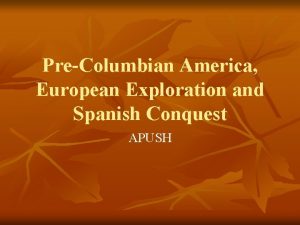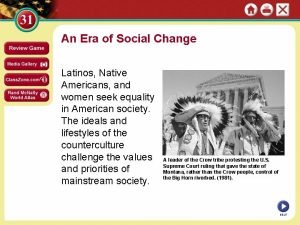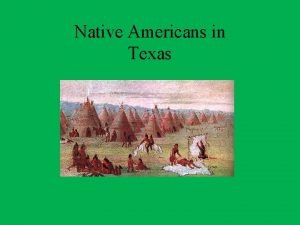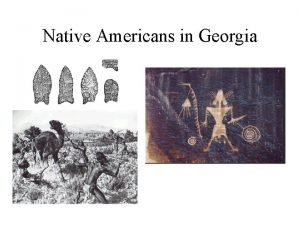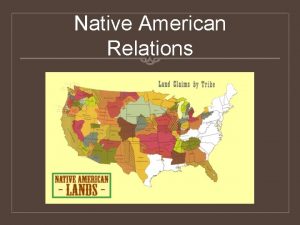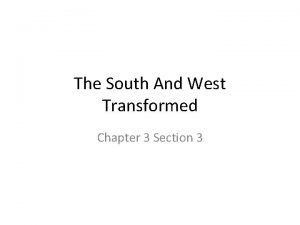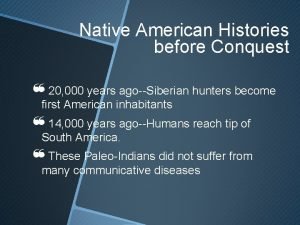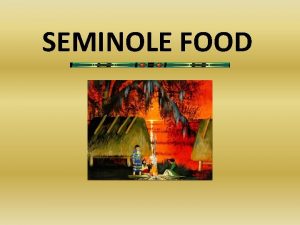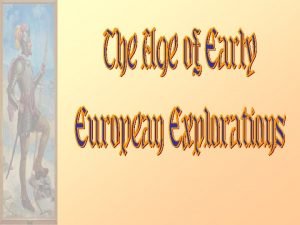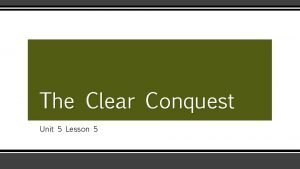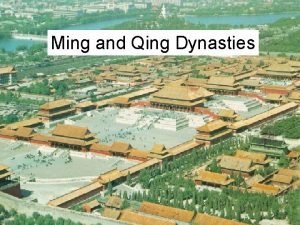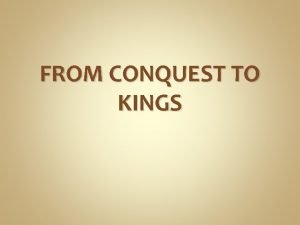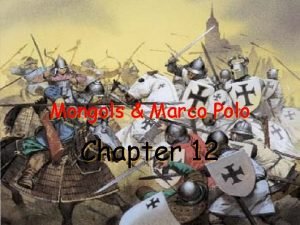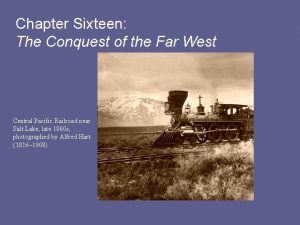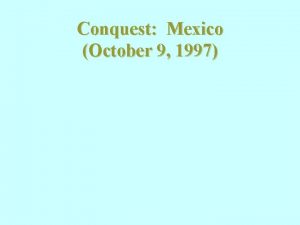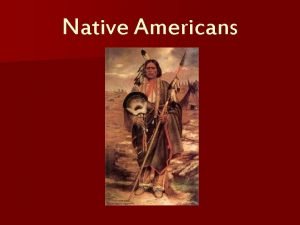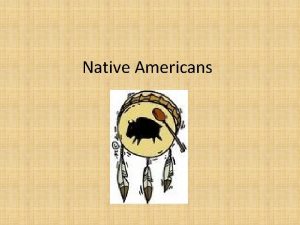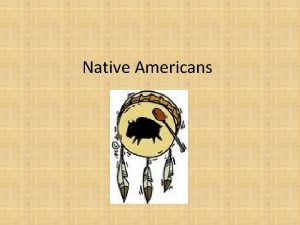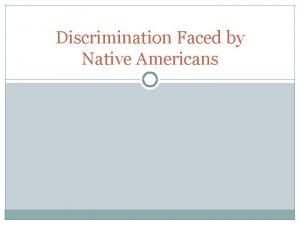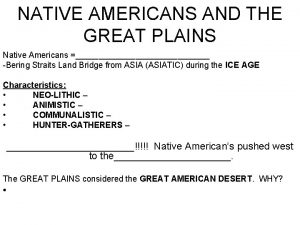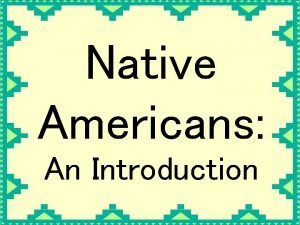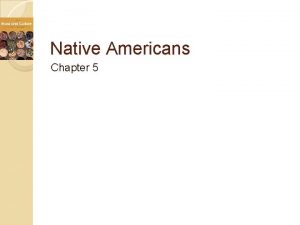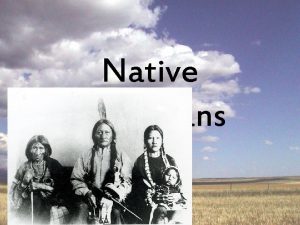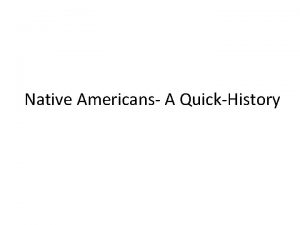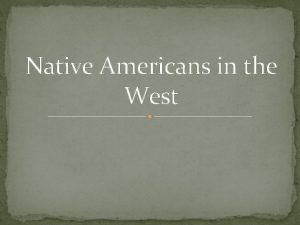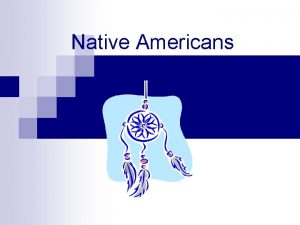Mexico Native Americans and the Spanish Conquest Native















- Slides: 15

Mexico Native Americans and the Spanish Conquest • Native peoples: Maya, Aztecs, Incas • Spanish conquest—Hernando Cortés lands on Mexican coast in 1519 - Tenochtitlán – Aztec capital - conquest is complete by 1521 • Gold and Silver make it an important colony • 1821 – Mexican Independence Continued. . . NEXT

• Francisco Madero, Pancho Villa, Emiliano Zapata lead revolution -1917 constitution gives half of farmland to peasants • Institutional Revolutionary Party (PRI)—new political party in 1929 - brings stability, but were corrupt • National Action Party’s Vicente Fox becomes president in 2000, Mexico becomes more democratic Continued. . . NEXT

The Aztecs and the Spanish • Cortes and Spanish destroy capital, build Mexico City on ruins • Spanish bring own language, religion - large mestizo population—mixed Spanish, Native American heritage An Architectural Heritage • Native Americans built pyramid temples, palaces • Spanish built missions, huge cathedrals Continued. . . NEXT

Economics: Cities and Factories Employment and Education • A growing population and poor government decisions have created job shortages • Many Mexicans emigrate to US for Work, but have a hard time getting good-paying jobs. • Many families live with extended family – including aunts, uncles, grandparents, etc. to help the family economically survive. NEXT

Central America Mayan • Cities were ruled by god-kings • Trade & religion center of cities - unknown why Maya abandoned many cities in 900 s. The Spanish • Spain ruled until mid-1800 s, then Mexico ruled Central America - Central American countries declared independence from Mexico in 1923 Continued. . . NEXT

Caribbean • In 1492 Columbus thought he’d reached East Indies • Spanish established sugar plantations, used natives as forced labor - disease, mistreatment kill many natives - Spanish bring in African slaves Independence • Haiti independence from France in 1804 • 1898 Spanish-American War gives Cuba independence from Spain in 1902 • Jamaica, Trinidad and Tobago don’t become independent from Britain until 1962 NEXT

Culture of Central America • Blends Native American and Spanish Culture of the Caribbean • Blends European African and Native American cultures Religion • Religions include Catholic, Protestant - Voodoo practiced on Haiti; Rastafarianism based in Jamaica Language • Spanish spoken in Cuba (11 mil) Dominican Republic (8. 5 mil) • French spoken in Haiti (6 mil) • English in Jamaica (3 mil) Continued. . . NEXT

Economics • Colonialism left laborers poor while planters got rich • Caribbean’s produce: sugar, citrus, coffee, spices • Central America’s produce: coffee, bananas • Panama Canal connects Atlantic, Pacific Oceans and is an important crossroads of world-trade Continued. . . NEXT

Popular Culture, Tourism, and Jobs • steel drum calypso • reggae music deals with social, religious issues • Population growth means high unemployment • Tourism is important; provides jobs Continued. . . NEXT

Spanish-Speaking South America Inca • Inca—civilization built in the Andes The Spanish Conquest • Pizarro conquers Incas for Spain; wants Incan gold, silver • Forces natives to work mines, farms; many abused, worked to death - moves Inca to plantations, disrupting families, communities Continued. . . NEXT

Independence Movements 1800 s - Simón Bolívar and José de San Martín helped liberate South America • Differing political ideas keeps countries from unifying Government • Instability – changes from oligarchy, democracy, military rule and dictator Cartel - Drug organizations that bring billions of dollars of illegal drugs into the United States Economy • Wide variety of products due to land, climate, vegetation Education • In Chile all children ages 6– 13 attend school; free public Continued. . . education NEXT

Brazil • Treaty of Tordesillas -1494 gives Portugal control of Brazil • No gold, silver, colonists clear forests for sugar plantations - Natives killed, Africans brought in to work Independence • Brazil is a colony of Portugal from 1500 to 1822 - Napoleon invades Portugal in 1807 - Portuguese royal court moves to Brazil • Brazil seeks independence after Napoleon’s defeat in 1815 - Brazilians ask Dom Pedro, son of Portugal’s king, to rule - Dom Pedro agrees, declares independence in September 1822 NEXT

A National Culture The People of Brazil • Today 200, 000 native peoples remain in Amazon rain forest Language - Portuguese Religion - Catholic Continued. . . NEXT

Economy Industry • Driven by an abundance of natural resources - Hydroelectric power fuels industry Migration to the Cities • Vast gap between rich & poor; poor seek jobs in cities -1960, 22% lived in cities; 1995, 75% lived in cities • 80% live within 200 miles of ocean Continued. . . NEXT

• Carnival—colorful feast day in Brazil & Caribbean - features music of the samba—Brazilian dance with African influences NEXT
 Spanish exploration and conquest apush
Spanish exploration and conquest apush Latinos and native americans seek equality
Latinos and native americans seek equality Coahuiltecan tattoos
Coahuiltecan tattoos Where did native americans come from
Where did native americans come from How many native americans died on the trail of tears
How many native americans died on the trail of tears What three circumstances hurt native american
What three circumstances hurt native american Native americans
Native americans What did the seminoles eat
What did the seminoles eat What is the cycle of conquest
What is the cycle of conquest The clear conquest
The clear conquest Qing conquest of the ming
Qing conquest of the ming Qing conquest of the ming
Qing conquest of the ming Joshua describes the conquest of canaan
Joshua describes the conquest of canaan Musique conquest of paradise
Musique conquest of paradise Conquest chapter 12
Conquest chapter 12 The conquest of the far west
The conquest of the far west
